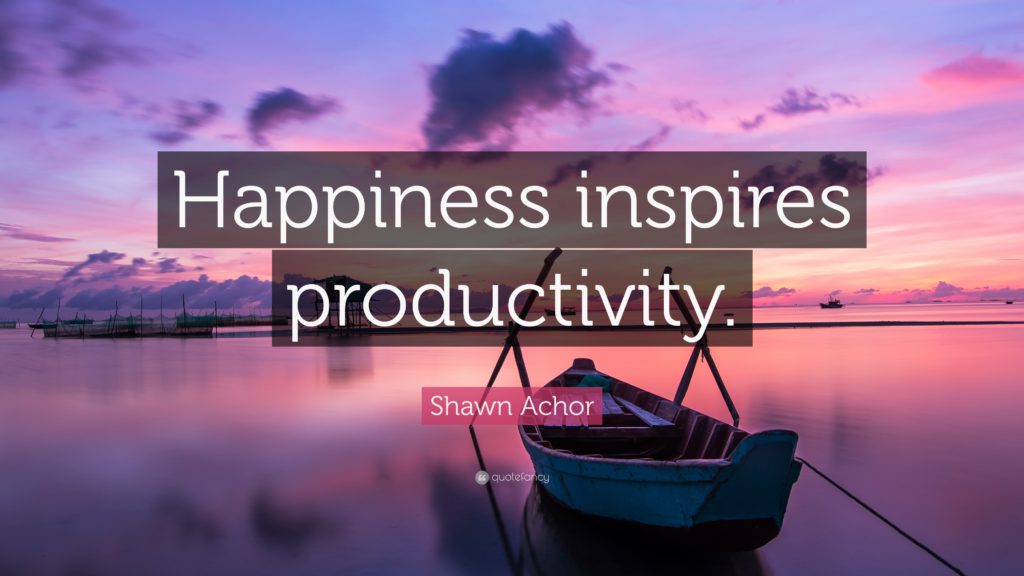There’s no bones about it: productivity is directly linked to happiness. When you focus on putting your employees’ well-being first, everyone benefits, including your bottom line.
In this post I’ll lay out 6 simple tips you can use to increase worker happiness and productivity.
Manage Expectations and Results
A big part of worker happiness has to do with how you manage expectations within your team. Most companies fail miserably on this point, going against what neuroscience tells us is the best way to focus on happiness. Here’s why:
Most firms focus on goals and objectives as a way of measuring their employees. This end-result mentality constantly pushes your workers’ ability to be happy back, until it becomes an unachievable aim. When one goal is reached, a new one replaces it, even if you congratulate or reward the employee for a job well done, you spend far more time focusing on the next big goal, rather than the small, consistent wins.
Instead, try shifting your focus to the process, rather than the result. Managing expectations in this way (saying that how you get there is as important as getting there), will cause your workers to strive for happiness everyday, not just when the quarterly results come in.

Related Post: Daily Habits for Self-Discipline and Success.
Empower, Don’t Dictate
Another tip is to do whatever it takes to empower your employees. Whenever possible, enable them to create more autonomy, and try not to micromanage too many of the details.
When workers feel like they are a cog in the machine, carrying out strict orders with no creative capacity, productivity goes down. Empowering them to create new and innovating solutions (even for small tasks) forces the brain to become more creative, which will quite literally kick them into a higher gear. This boost in creativity will be more likely to make them feel better about their work, and they might even find better solutions in the process.
Use Proven Stress-Relief Tactics
Stress is a powerful destructive force. It is absolutely imperative that your employees know proven skills and strategies for relieving stress when it arises, and learn how to manage their daily stress levels.
This may take time to learn, but the results are powerful. When your employees can learn to manage their own stress, they can better balance excitement and enthusiasm for a project without feeling overwhelmed. Not only will this increase day to day efficiency, but it will also lead to lower burnout rates and higher employee retention in the long run.
Create a Light-Friendly Space
Open layouts with lots of natural light are better than crammed cubicles. In addition to encouraging more open communication flow, the right office layout can also boost mental performance, causing different neuro-receptors to fire, meaning your employees will be more open, receptive, and creative. For an added bonus, add a few plants, which will purify the air and create a higher degree of workplace harmony.
Encourage Mid-Day Resets
No one can work 8+ hours without needing time to rest and reset. While you probably already allow for a lunch hour and a few other short breaks throughout the day, you can go the extra mile by teaching your workers how to reset and recharge mentally throughout the day.
These breaks don’t have to be long. As little as 5 or 10 minutes is plenty of time to mentally recharge and re-energize someone towards a goal, as long as it’s done properly. Train your employees to use visualization or breath techniques to reset and refocus, and you’ll see a big jump in their morale and productivity.

Provide Wellness Trainings
Employee happiness is a learned trait. It combines a number of factors that include both your company and team culture as well as the individual employees mindset and natural mental habits.
The best way to increase worker happiness in the long run is to make sure they have the tools and skills they need to create this happiness for themselves, and the best way to do that is to provide wellness trainings.
We offer a number of programs designed to help employees learn to manage stress, improve their mindset, and boost productivity by focusing on their individual well-being.




